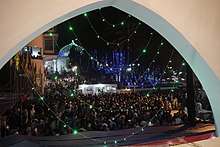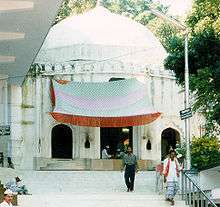Shah Jalal
| Shah Jalal | |
|---|---|
 Shah Jalal Mazar | |
| Religion | Islam |
| Denomination | Sufi |
| Personal | |
| Born |
1271 CE Konya, Sultanate of Rum (now in Turkey) |
| Died |
1346 (aged 74–75) Sylhet, Bengal Sultanate (now in Bangladesh) |
| Senior posting | |
| Based in | Sylhet |
| Title | Shaykh-al-Mashāykh, Al-Mujarrad |
| Period in office | Late 13th century to early 14th century |
| Predecessor | S. Ahmed Kabir |
| Successor | Shah Paran |
| Religious career | |
| Post | Sufi saint and mystic |

Shāh Jalāl ad-Dīn al-Mujarrad al-Naqshbandi (Arabic: شاه جلال الدين المجرد النقشبندي), popularly known as Hazrat Shah Jalal (Arabic: شاه جلال, Bengali: শাহ জালাল, Sylheti: ꠡꠣꠢ ꠎꠣꠟꠣꠟ) (1271 CE – 15 March 1346 CE), is a celebrated Sufi Muslim figure in Bengal. Jalal's name is associated with the spread of Islam into north-eastern Bengal through Sufism, part of a long history of travel between the Middle East, Persia, Central Asia and South Asia. According to a tablet inscription found in Amberkhana, he arrived at Sylhet in 1303 CE.[1] The largest airport in Bangladesh, Hazrat Shahjalal International Airport, is named after him.
History
His biography was first recorded in the mid 16th century by a certain Shaikh 'Ali (d. 1562), a descendant of one of Shah Jalal's companions. Thus there is a gap of several centuries between the life of the saint and that of his earliest biographer. According to this account, Shah Jalal had been born in Turkestan, where he became a spiritual disciple of Saiyid Ahmad Yasawi, one of the founders of the Central Asian Sufi tradition.[2] Therefore, although his existence is not debated, much of his life story is debated.
Early life and education
Born Jalāl ad-Dīn bin Mahmoud and became a makhdoom, teacher of Sunnah and, for performing prayers in solitary milieu and leading a secluded life as an ascetic, al Mujarrad was postfixed to his name. He was conferred with the title of Shaykh-ul-Mashāykh (Great Scholar). Shah Jalal's date and place of birth is not certain. Various traditions and historical documents differ. A number of scholars have claimed that he was born in 1271 CE in Konya in modern-day Turkey (then in the Sultanate of Rûm) and later moved to Yemen either as a child or adult while many believe he was born in a village called Kaninah in Hadhramaut, Yemen. His mother, Syeda Hasina Fatimah, and his father, Mahmoud bin Mohammed bin Ibrahim, were descendants of Hashemite dynasty of Quraysh of Mecca.[3] His father was a Muslim cleric, who was a contemporary of the Persian poet and Sufi mystic, Jalal ad-Din Muhammad Rumi. Shah Jalal was educated and raised by his maternal uncle Syed Ahmed Kabir in Mecca. He excelled in his studies; became a hafiz and mastered fiqh. He achieved spiritual perfection (Kamaliyyat) after 30 years of study, practice and meditation.[4]
Travel to South Asia
According to legend, one day his uncle, Sheikh Kabir gave Shah Jalal a handful of soil and asked him to travel to India. He instructed him to choose to settle and propagate Islam in any place in India where the soil exactly matches that which he gave him in smell and colour.[5] Shah Jalal journeyed eastward and reached India in c. 1300, where he met many great scholars and Sufi mystics.[5]
Conquest of Sylhet
In 1303 the Sultan of Bengal, Shamsuddin Firoz Shah was engaged in a war with the neighbouring kingdom of Sylhet, then under the rule of the Hindu king Gour Govinda. This war began when Burhanuddin, a Muslim living in Sylhet sacrificed a cow for his newborn son’s Aqiqah or celebration of birth.[6] According to tradition, Govinda learned of this sacrifice when a piece of beef from the cow was picked up by a bird which was then dropped on the King’s personal temple. Govinda, in a fury for what he saw as sacrilege, had the newborn killed as well as having Burhanuddin’s right hand cut off.[7]
When word of this reached Firoz Shah, an army commanded by his nephew Sikander Khan was sent against Gour Govinda. Two successive strikes were attempted, both ending in failure due to the Bengali armies inexperience in the foreign terrain as well as Govinda’s superior military strategy.[8][9]
A third attack, now under the additional leadership of Firoz Shah’s Sipah Salar (Commander-in-Chief) Syed Nasiruddin was undertaken, a force which was joined by Shah Jalal and his companions who at this point numbered 360.[10] Shah Jalal, who had immediately prior to this been a guest of the Sufi saint Nizamuddin Auliya in Delhi, may have been summoned by Firoz Shah for aid after the initial failed attacks against Gour Govinda. Alternatively he may already have been present in Sylhet, fighting against the Hindu king independently prior to being approached by the Sultan.[11][12]
The army was then guided through Sylhet by Burhanuddin, ultimately arriving at the banks of the Barak River. Here the third battle was fought between Gour Govinda and the combined armies of Shah Jalal and Syed Nasiruddin, with the latter forces ultimately claiming victory. Govinda was forced to retreat and Sylhet was brought under Muslim control. According to tradition, Shah Jalal at this point compared the soil in Sylhet with that which was previously given to him by his uncle, finding them to be identical. In any case, following the battle he, along with his followers permanently settled in Sylhet.[13][14]
Later life
During the later stages of his life, Shah Jalal devoted himself to propagating Islam. Shah Jalal became so renowned that the famous traveller Ibn Battuta, then in Satgaon,[15] made a one-month journey through the mountains of Kamarupa north-east of Sylhet to meet him.[16] On his way to Sylhet via Habung, Ibn Batuta was greeted by several of Shah Jalal's disciples who had come to assist him on his journey many days before he had arrived. At the meeting in 1345 CE, Ibn Batuta noted that Shah Jalal was tall and lean, fair in complexion and lived by the mosque in a cave, where his only item of value was a goat he kept for milk, butter, and yogurt. He observed that the companions of the Shah Jalal were foreign and known for their strength and bravery. He also mentions that many people would visit the Shah to seek guidance.[17]
The meeting between Ibn Batuta and Shah Jalal is described in his Arabic travelogue, Rihla (The Journey). Amir Khusrau also gives an account of Shah Jalal's conquest of Sylhet in his book Afdalul Hawaade. Even today in Hadramaut, Yemen, Shah Jalal's name is established in folklore.[18]
The exact date of his death is debated, but he is reported by Ibn Batuta to have died on 20 Dhul Qadah 746 AH (15 March 1346 CE).[19] He left behind no descendants and was buried in Sylhet in his dargah (tomb), which is located in a neighbourhood now known as Dargah Mahalla:
His shrine is famous in Sylhet and throughout Bangladesh, with hundreds of devotees visiting daily. The largest mosque in Sylhet was built at the Dargah (also one of the largest in Bangladesh).
Spiritual genealogy
Spiritual genealogy of Shah Jalal is as follows:
- Prophet Muhammad
- Ali ibn Abi Talib
- Hasan al-Basri
- Habib al-Ajami
- Maruf Karkhi
- Sirri Saqti
- Sheikh Mamshad Dinnuri
- Sheikh Ahmad Aswad Dinnuri[21]
- Sheikh Abu Muhammad Amwiya
- Sheikh Azi Uddin Shohrawardi
- Sheikh Abu Nazib Ziauddin
- Sheikh Hisab Al-Din
- Sheikh Makhdum
- Baha-ud-din Zakariya
- Jalaluddin Surkh-Posh Bukhari
- Sheikh Ahmad Kabir Suhrawardi
- Shah Jalal[22]
- Shah Paran
Eponyms
- Shahjalal University of Science and Technology, Bangladeshi public university located in Sylhet
- Hazrat Shahjalal International Airport, Bangladeshi airport in Dhaka; nation's largest international gateway
- Shahjalal Fertiliser Factory, Bangladeshi fertiliser factory
- Shahjalal Islami Bank Limited, Bangladeshi bank
- Shahjalal Jam-e Mosque, a mosque in UK
- Shahjalal Disability Institute, an institute in Sylhet
See also
- Moinuddin Chishti
- Shah Paran, his nephew and another Sufi saint
- Shah Siddiq, one of Shah Jalal's 360 followers and Sufi saint
- Nizamuddin Auliya, his spiritual Friend also gave him two pairs of black pigeons, later named Jalali kobutor
- Syed Nasiruddin
References
- ↑ Ahmed, Shamsuddin, Inscription of Bengal, vol. iv, Dhaka (1960), p 25
- ↑ Eaton, Richard M. (1993). The Rise of Islam and the Bengal Frontier, 1204–1760 (PDF). Berkeley: University of California Press. Archived from the original (PDF) on 21 June 2016.
- ↑ Rahman, M. F., Hazrat Shah Jalal and 360 Awliya, Deshkaal Publications, Sylhet, 1992, p.12-13
- ↑ Islam in South Asia in practice source of shuhel-e-yamani By Barbara Daly Metcalf, Published by – Princeton universiti press, 2009. Page 385
- 1 2 Karim, Abdul (2012). "Shah Jalal (R)". In Islam, Sirajul; Jamal, Ahmed A. Banglapedia: National Encyclopedia of Bangladesh (Second ed.). Asiatic Society of Bangladesh.
- ↑ name=Banglapedia>Hussain, M Sahul (2014). "Burhanuddin (R)". Banglapedia: National Encyclopedia of Bangladesh (Second ed.). Asiatic Society of Bangladesh.
- ↑ EB, Suharwardy Yemani Sylheti, Shaikhul Mashaikh Hazrat Makhdum Ghazi Shaikh Jalaluddin Mujjarad, in Hanif, N. "Biographical Encyclopaedia of Sufis: Central Asia and Middle East. Vol. 2". Sarup & Sons, 2002. p.459
- ↑ Bangladesh Bureau of Statistics, Statistics Division, Ministry of Planning, Government of the People's Republic of Bangladesh,"Population Census of Bangladesh, 1974: District census report" (1979), p. 15
- ↑ Mujjarad (2002, p. 459)
- ↑ Mujjarad (2002, p. 460)
- ↑ Mujjarad (2002, p. 460)
- ↑ "Journal of the Asiatic Society of Bengal, Volume 42" (1873), p. 279
- ↑ name=Banglapedia>Hussain, M Sahul (2014). "Burhanuddin (R)". Banglapedia: National Encyclopedia of Bangladesh (Second ed.). Asiatic Society of Bangladesh.
- ↑ Mujjarad (2002, p. 460)
- ↑ Hazrat Shah Jalal O Sylhet er Itihas by Syed Mujtaba Ali, re-published by Utsa Prakashan, Dhaka, 1988, p.60
- ↑ Rihla 9, 1344
- ↑ Islam in South Asia in practice By – Barbara Daly Metcalf, Published – Princeton university press Uk 2009, Page 383 – 385.
- ↑ The rise of Islam and the Bengal frontier, 1204–1760, By Richard Maxwell Eaton, Published by – university of california press, page 76
- ↑ Rahman, M. F., Hazrat Shah Jalal and 360 Awliya, p.13, Deshkaal Publications, Sylhet, 1992
- ↑ Ziaul Haque, Md., Hazrat Shah Jalal (R.A): An Epic, p.114, Choitonno Publication, Sylhet, 2015
- ↑ Systems, Cognitive (2012-04-08). "The seven golden chains of Shaykh Muhammad Siraj ad-Din Naqshbandi (d.1915)". Ghaffari. Retrieved 2017-07-09.
- ↑ Islam in South Asia in practice, By Barbara Daly Metcalf, Published by Princeton universiti press.
External links
| Wikimedia Commons has media related to Shah Jalal Mazar. |